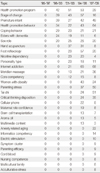Abstract
Methods
The main variables were key words from the research papers that were presented in the Journal of Korean Academy of Nursing and journals of the seven branches of the Korean Academy of Nursing. English titles and abstracts of the papers (n=5,936) published from 1995 through 2009 were included. Noun phrases were extracted from the corpora using an in-house program (BiKE Text Analyzer), and their co-occurrence networks were generated via a cosine similarity measure, and then the networks were analyzed and visualized using Pajek, a Social Network Analysis program.
Figures and Tables
References
1. Batagelj V, Mrvar A. Pajek: Program for analysis and visualization of large networks. Timeshift-The World in Twenty-Five Years: Ars Electronica. 2004. Retrieved January 24, 2011. 242–251. from http://90.146.8.18/en/archiv_files/20041/FE_2004_batageljmrvar_en.pdf.
2. Barrett EM. What is nursing science? Nursing Science Quarterly. 2002. 15:51–60.
3. Boyack KW, Klavans R, Börner K. Mapping the backbone of science. Scientometrics. 2005. 64:351–374.
4. Effken J, Gephart S, Bianchi D, Verran J. Correlations of nursing communication network metrics with patient outcomes. Annual Symposium proceedings/AMIA Symposium. AMIA Symposium. 2010. 2010:197–201.
5. Estabrooks CA, Winther C, Derksen L. Mapping the field: A bibliometric analysis of the research utilization literature in nursing. Nursing Research. 2004. 53:293–303.
6. Goh KI, Cusick ME, Valle D, Childs B, Vidal M, Barabási AL. The human disease network. Proceedings of the National Academy of Sciences of the United States of America. 2007. 104:8685–8690. doi: 10.1073/pnas.0701361104.
7. He Q. Knowledge discovery through co-word analysis. Library Trends. 1999. 48(1):133–159.
8. Jang SO. Analysis of research papers published in the Journal of Korean Academy of Nursing by the classification of knowing in nursing. Journal of Korean Academy of Nursing. 2005. 35:206–212.
9. Jeong S, Kim HG. Intellectual structure of biomedical informatics reflected in scholarly events. Scientometrics. 2010. 85:541–551.
10. Jeong S, Lee SK, Kim HG. Knowledge structure of Korean medical informatics: A social network analysis of articles in journal and proceedings. Healthcare Informatics Research. 2010. 16:52–59.
11. Kang HC. Last 3 years (1999-2001) Journal of nursing for the use of statistical techniques for analysis. Journal of Korean Academy of Nursing. 2002. 32:929–935.
12. Kim JI, Park SM, Park HS, Chung CW, Ahn SH. Analysis of published papers and their keywords in the Korean Journal of Women Health Nursing (2003-2006). Korean Journal of Women Health Nursing. 2007. 13:51–59.
13. Kim SJ, Kim KB, Yi MS, Lee KJ, Ahn YH, Kim HS, et al. The trends of nursing research in the journals of seven branches of the Korean Academy of Nursing. Journal of Korean Academy of Nursing. 2002. 32:114–130.
14. Kleinberg J. Authoritative sources in a hyperlinked environment. Journal of the ACM. 1999. 46:604–632.
15. Lee MA, Yom YH. A comparative study of patients' and nurses' perceptions of the quality of nursing services, satisfaction and intend to revisit the hospital: A questionnaire survey. International Journal of Nursing Studies. 2007. 44:545–555.
16. McCloskey Dochterman J, Bulechek G. Nursing interventions classification (NIC). 2004. 4th ed.St. Louis, MO: Mosby.
17. Park JS, Park CJ. An analysis of nursing research on pain reported in Korea from 1970 to 1994. Journal of Korean Academy of Nursing Administration. 1995. 25:30–44.
18. Roh KH. A review of the trends of journal research on dementia and nursing interventions for demented elders. Journal of Korean Academy of Community Health Nursing. 2008. 19:300–309.
19. Salton G. Developments in automatic text retrieval. Science. 1991. 253(5023):974–980.
20. Scott J. Social network analysis. Sociology. 1988. 22(1):109–127. doi: 10.1177/0038038588022001007.
21. Seomun GA, Koh MS, Kim IA. Classification of keywords of the papers from the Journal of Korean Academy of Nursing Administration (2002-2006). Journal of Korean Academy of Nursing Administration. 2007. 13:118–122.
22. Shin HS, Hyun MS, Ku MO, Cho MO, Kim SY, Jeong JS, et al. Analysis of research papers published in the Journal of the Korean Academy of Nursing-focused on research trends, intervention studies, and level of evidence in the research. Journal of Korean Academy of Nursing. 2010. 40:139–149.
23. Sohng KY, Kim JI, Choi DW, Kim AK, Chaung SK, Kim KH, et al. Research trends in the Journal of Korean Academy of Fundamental Nursing. Journal of Korean Academy of Fundamentals of Nursing. 2008. 15:262–273.
24. Suh YO, Park JS, Yang JH, Kim HW, Suk MH, Shin HS, et al. Analysis of research papers published in the Journal of Korean Academy of Nursing. Journal of Korean Academy of Nursing. 2007. 37:1013–1019.
25. Wilkinson DM, Huberman BA. A method for finding communities of related genes. Proceedings of the National Academy of Sciences of the United States of America. 2004. 101:Suppl 1. 5241–5248. doi: 10.1073/pnas.0307740100.




 PDF
PDF ePub
ePub Citation
Citation Print
Print







 XML Download
XML Download